
Science Education Center of California

Science Education Center
of California
3001 Chapel Hill Road
Orange, CA 92867
714-292-6845
krawitz@sprynet.com
![]()
Science Education Center of California
Petrified Tree Stumps
Complete Petrified Tree Stumps |
||
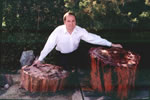 |
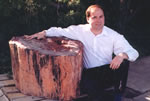 |
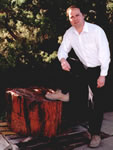 |
| The Krawitz Collection of Petrified Wood features over 4,000 pounds of perfectly preserved petrified tree stumps. Most of the tree stumps have complete fossilized bark around the entire perimeter of the tree, and show in minute detail their growth rings, central tree core, and exterior fossilized bark. These petrified tree stumps were discovered many years ago on private land to the south of route 180 and a few miles south of what is now the Petrified Forest National Park. The petrified wood ranges in size from a few pounds to about 1,000 pounds. The thousand pound giant ($6,000 dollars) is shown with its owner and is resting comfortably on a wooden pallet. The slightly smaller stump (to the left of the pallet and shown in the upper left photo) is approximately 400 pounds and is valued at around $1,500. |
||
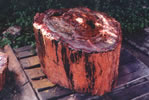 |
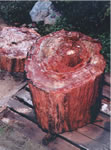 |
|
| Prices: With the exception of
three petrified trees, all tree stumps are priced at $3 per
pound.
Color: Mineral impurities (especially iron) are responsible for the attractive colors (purple and red) and interesting patterns. Quality and availability: The petrified stumps at the Science Education Center are almost exclusively museum quality and are available to the general public in their raw uncut state. This is not the common practice with museum quality material. The finest quality petrified wood is usually transformed into slabs, bookends, spheres and a variety of other products. |
||
| ^ top ^ | ||
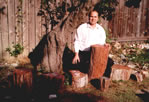 |
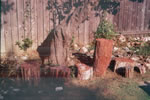 |
|
| Composition and formation: About 225 million years ago, the Painted Desert of Arizona was a large, heavily wooded forest, rich in tall pine-like trees. Small dinosaurs and giant fish eating amphibians roamed the area and testify to the abundance of life that existed in what is now a desert. Woodworthia, Araucarioxylon and Schilderia trees flourished in the area, and some were washed into a vast flood plane that was rich in silicic acid. The silica bearing groundwater slowly dissolved the wood tissue, and cell by cell produced a perfect casting of the trees. Over millions of years, heat and pressure lifted the fossil bearing sediment to its present elevation of around 5,400 feet. The soft white sedimentary clay that surrounds the petrified trees has eroded extensively and many of the petrified trees (which are more resistant to erosion) lay on the surface of the ground or a few feet below the surface. | ||
Planning a Visit | Site Map | FAQs | Links
© Copyright 2019 Science Education Center, all rights reserved.